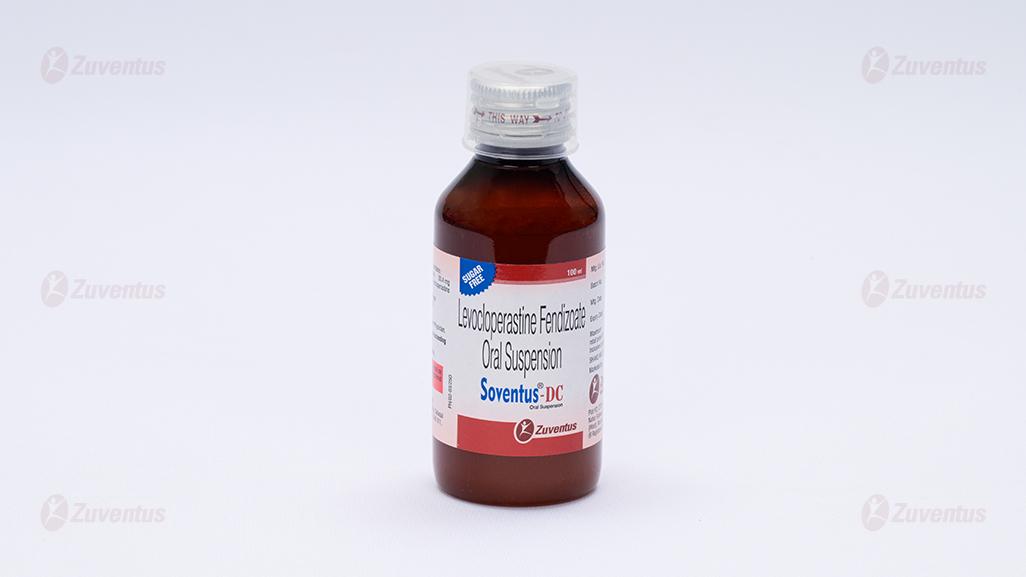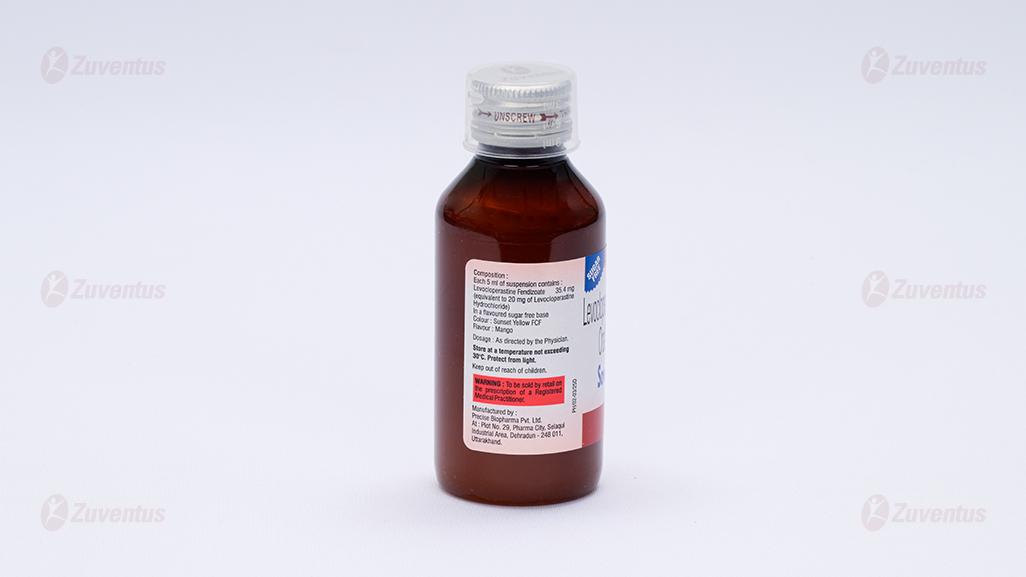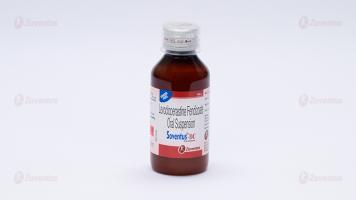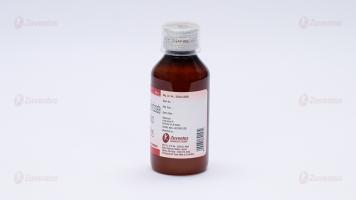Soventus DC Syrup
Therapy Area
Respiratory
1.0 Generic Name
Levocloperastine Fendizoate Oral Suspension
2.0 Qualitative and quantitative composition
Each 5 ml oral suspension contains:
Levocloperastine Fendizoate 35.4 mg (equivalent to 20 mg of Levocloperastine Hydrochloride)
Excipients q.s.
In a flavoured syrup base
Colour: Sunset Yellow FCF
Flavour: Mango
3.0 Dosage form and strength
Oral suspension
20mg of Levocloperastine per 5ml
4.0 Clinical particulars
4.1 Therapeutic Indication
For the treatment of non-productive cough in adult patients
4.2 Posology and method of administration
Dose for Adults: 5 ml (20mg) three times daily.
4.3 Contraindications
- Known hypersensitivity to cloperastine or to any of the excipients.
- It should not be used in children under 2 years of age.
- Pregnant or breast-feeding women.
- Known hypersensitivity to antihistaminic agents.
- Patients receiving concomitant treatment with MAO inhibitors.
- Patients with hereditary fructose intolerance, glucose or galactose malabsorption, or sucrose isomaltase deficiency.
- Consumption of Alcohol is strictly contraindicated with Levocloperastine suspension.
4.4 Special warnings and precautions for use
Caution should be observed while prescribing Levocloperastine Fendizoate suspension to adults and children with hypertension, cardiovascular disease, uncontrolled diabetes mellitus, hyperthyroidism, seizures or in patients who are unusually hypersensitive to sympathomimetic amines.
Due to its mild anticholinergic activity, cloperastine should be administered with caution in patients with intraocular hypertension, narrow-angle glaucoma, prostatic hypertrophy, urine retention, hypertension, cardiac arrhythmia, myasthenia gravis, stenosing peptic ulcer or bowel obstruction affecting the oesophagus, intestine or bladder.
Persistent cough.
Caution is recommended in patients with chronic cough such as smoker's cough, pulmonary emphysema or asthma, as it inhibits the cough reflex and could therefore alter expectoration and increase airway resistance.
4.5 Drugs interactions
Levocloperastine Fendizoate suspension should not be concomitantly prescribed with sedatives or tranquilizers. Similarly, other antihistamine drugs should not be prescribed concomitantly.
As it has some antihistaminic activity, cloperastine can enhance the sedative effect of CNS
depressors such as anxiolytics, antipsychotic drugs, barbiturates, hypnotics, narcotics, sedatives, tranquilizers, some analgesics and alcohol.
Also due to this activity, cloperastine, antihistaminic agents and anticholinergic drugs (anti-parkinson's drugs, tricyclic antidepressants, MAO inhibitors, neuroleptic agents) can reciprocally increase their effects.
Expectorants and mucolytic drugs: Inhibition of the cough reflex could give rise to pulmonary obstruction in case of elevated volume or fluidity of bronchial secretions.
4.6 Use in special populations
Animal studies have not shown any evidence of damage to the foetus. In humans, its safety for use in pregnancy and lactation has not been established. Cloperastine should therefore not be used during pregnancy unless a doctor believes that the treatment's potential benefit for the mother exceeds all risks for the developing foetus or infant. As it is unknown whether the drug is excreted in human milk, its use during lactation is not recommended.
4.7 Effects on ability to drive and use machines
Levocloperastine can cause drowsiness, so caution is recommended when driving or using dangerous machinery. If drowsiness is noted at normal doses of cloperastine, do not drive or handle dangerous machinery.
4.8 Undesirable effects
Levocloperastine can produce minor and transient adverse reactions such as Dry mouth, GI effects, exhaustion, fainting, somnolence, sedation, clouding of consciousness, numbness, dizziness, headache, palpitations and allergic reaction.

Reporting of suspected adverse reactions
Reporting suspected adverse reactions after authorisation of the medicinal product is important. It allows continued monitoring of the benefit/risk balance of the medicinal product. Healthcare professionals are asked to report any suspected adverse reactions via email to:medico@zuventus.com
Website: https://www.zuventus.co.in/drug-safety-reporting
By reporting side effects, you can help provide more information on the safety of this medicine.
4.9 Overdose
No cases of overdose have been reported.
Intoxication can occur after ingesting quantities that are much higher than the therapeutic doses.
Overdose could cause symptoms such as drowsiness, anticholinergic symptoms, hallucinations, excitation, ataxia, lack of motor coordination and convulsions. In case of overdose, symptomatic and maintenance treatment is recommended. Vomiting should be induced or stomach lavage should be performed with saline serum.
5.0 Pharmacological properties
5.1 Mechanism of action
Levocloperastine is a cough suppressant. Levocloperastine is a novel antitussive agent having dual mechanism of action, it acts on both the central bulbar cough centre and on peripheral receptors in the tracheobronchial tree.
As demonstrated in a number of animal models, Levocloperastine acts at the CNS level by inhibiting the bulbar cough centre. In addition to this primary mechanism of action, peripheral effects related to its antihistamine, anti-serotonergic and smooth muscle-relaxant properties also contribute to the overall efficacy of Levocloperastine in the treatment of cough, bronchospasm and related symptoms.
5.2 Pharmacodynamic properties
The therapeutic efficacy of DL-cloperastine in reducing the intensity and frequency of cough is well established, with efficacy similar to that of codeine and superior to that of dextromethorphan.
In clinical trials, levocloperastine had a faster onset of action and produced greater reductions in the intensity and frequency of cough compared with DL-cloperastine, codeine and levodropropizine.
The antitussive effects (reduction in intensity and frequency of cough) of levocloperastine were observed after the first day of treatment in patients of all ages. In children, levocloperastine reduced night-time awakenings and irritability; in adults, it was also effective in treating ACE inhibitor cough.
Levocloperastine was generally well tolerated. There was no evidence of clinically significant central adverse events, whereas drowsiness, dry mouth and nausea were reported with comparator agents (levodropropizine, codeine, DL-cloperastine).
Levocloperastine represents an effective alternative to currently used antitussive agents with the added advantage of faster onset of action and improved tolerability in all patient groups.
5.3 Pharmacokinetic properties
The product is absorbed from the gastrointestinal tract and mostly excreted in urine.
After administration of 10ml of oral suspension containing levocloperastine fendizoate, peak plasma concentrations of 10 μg/L were reached 2 to 4 hours after administration, with a lag-time of approximately 45 minutes before detection of the drug in the bloodstream, suggesting a gradual and protracted absorption from the intestine.
Oral bioavailability was >40% based on the ratio of area under the plasma concentrationtime curve (AUC) of unmodified drug calculated after oral and intravenous administration, while substantially higher values were obtained in excretion studies conducted with radiolabelling techniques (14C).
The half-life of levocloperastine is 0.80 hours (distribution half-life), 1.68 hours (elimination half-life), and 6.58 hours (terminal elimination half-life). The volumes of distribution (Vd) were found to be 80 ml/kg (terminal) and 57 ml/kg (at steady state), and the protein-bound fraction was high. Total body clearance was 7.5 L/hour.
6.0 Nonclinical properties
In preclinical studies, levocloperastine demonstrated antitussive effects similar to those observed with codeine. In acute and repeated-dose toxicity studies, levocloperastine was well tolerated in rodents and dogs, with no clinically significant cardiovascular or gastrointestinal adverse events. The pharmacokinetic behaviour of levocloperastine, best described by a two-compartmental model with absorption phase, is similar to that of the racemic compound DL-cloperastine.
Administration of levocloperastine 1 to 9 mg/kg to guinea pigs dose-dependently inhibited cough induced by citric acid or ammonia vapour, showing an antitussive effect similar to that of codeine. The 50% effective dose (ED50) values for levocloperastine vs codeine were, respectively, 2.6 vs 3.6 mg/kg in the citric acid test, and 2.9 vs 3.1 mg/kg in the ammonia test. Activities of levocloperastine, DL-cloperastine and dextrocloperastine were similar in the citric acid-induced cough model, suggesting that the antitussive efficacy of cloperastine compounds is independent of their enantiomeric structure.
Levocloperastine (as well as dextrocloperastine and DL-cloperastine) exhibited spasmolytic activity in guinea-pigs via its antihistamine properties in vitro (inhibition of histamine-induced contraction in isolated tracheal rings) and in vivo (dose-dependent inhibition of bronchospasm induced by histamine aerosol). Similarly, serotonin-antagonist activity was demonstrated in vitro.
Unlike opioid antitussives, such as codeine, the CNS activity of levocloperastine is highly selective for the cough centre, thus avoiding central adverse effects such as sedation. This attenuation of CNS adverse effects is a differential feature of levocloperastine and is related to its specific stereoisomeric properties, since dextrocloperastine and DL-cloperastine, administered orally or intraperitoneally, induced sedative and stimulant effects of much greater magnitude (by approximately 50%) in tests of CNS function in rodents.
Both acute and repeated-dose toxicity studies found levocloperastine to be well tolerated in rodents and dogs. The 50% lethal dose (LD50) value of levocloperastine could not be calculated because the oral/intraperitoneal doses tested (up to 2000 mg/kg) did not cause death in any of the experimental animals. By comparison, the enantiomer dextrocloperastine was more toxic, with LD50 values of 466 mg/kg in the mouse and 1226 mg/kg in the rat after oral administration, and 155 and 177 mg/kg, respectively, after intraperitoneal administration.
In chronic toxicity studies, levocloperastine at dosages up to 75 mg/kg/day (corresponding to 45 times the therapeutic daily dosage in humans) for 6 months was considered 'safe' in rats and dogs. Mild adverse events (including vomiting, anorexia and transient biochemical/ histological signs of liver and kidney dysfunction) were observed only with dosages of 250 mg/kg/day following 6 months' treatment. Levocloperastine did not show mutagenic or carcinogenic effects in specific in vitro and in vivo studies.
7.0 Description
Levocloperastine, the levorotatory isomer of DLcloperastine, is a centrally active, non-opioid antitussive agent with a chemical structure and pharmacological profile distinct from that of the racemate. It is devoid of central antinociceptive activities, does not cause addiction or dependence phenomena, and does not interfere with cardiovascular or gastrointestinal functions.
Cloperastine fendizoate is a N-oxyethylpiperidine. It is functionally related to a benzoate.

Structure of Cloperastine fendizoate
Molecular Formula: C40H38ClNO5
Molecular Weight: 648.2 g/mol
8.0 Pharmaceutical particulars
8.1 Incompatibilities
None known.
8.2 Shelf-life
Refer on the pack.
8.3 Packaging information
A bottle of 100 ml.
8.4 Storage and handing instructions
Store in a cool place. Protect from light. Keep out of reach of children. Shake well before each use.
9.0 Patient Counselling Information
- You have been prescribed Soventus-DC Oral Suspension for the symptomatic relief of dry cough.
- It is usually taken for a short time, until the symptoms clear up.
- Measure the syrup with a special dose-measuring spoon or cup, not a regular table spoon.
- Drink extra fluids to help loosen the congestion and lubricate your throat while you are taking this medication.
- It should not be administered to patients with chronic cough or where cough is accompanied by excessive secretions.
- Inform your doctor if your cough lasts more than 7 days, comes back, or occurs with fever, rash or headache. These could be signs of a serious condition.
12.0 Date of revision of text
19-09-2024
Read all of this leaflet carefully before you start taking this medicine because it contains important information for you.
- Keep this leaflet. You may need to read it again.
- If you have any further questions, ask your doctor or pharmacist.
- This medicine has been prescribed for you only. Do not pass it on to others. It may harm them, even if their signs of illness are the same as yours.
- If you get any side effects, talk to your doctor or pharmacist. This includes any possible side effects not listed in this leaflet.
What is in this leaflet:
1. What Soventus®-DC Oral Suspension is and what it is used for
2. What you need to know before you take Soventus®-DC Oral Suspension
3. How to take Soventus®-DC Oral Suspension
4. Possible side effects
5. How to store Soventus®-DC Oral Suspension
6. Contents of the pack and other Information
1. What is Soventus®-DC Oral Suspension and what it is used for
Soventus®-DC Oral Suspension contains Levocloperastine as an active ingredient. Levocloperastine is an antitussive (cough suppressant) used primarily for the treatment of dry cough. It works by blocking receptors in the brain, reduces the activity of the cough center in the brain that trigger the cough reflex. It helps to alleviate coughing.
Soventus®-DC Oral Suspension is commonly used for the treatment of non-productive cough in adult patients. Non-productive coughs, which do not bring up mucus, can be particularly bothersome and may arise from various conditions, such as allergies or respiratory irritations.
2. What you need to know before you take Soventus®-DC Oral Suspension
Do not take Soventus®-DC Oral Suspension if:
- Known hypersensitivity to cloperastine or to any of the excipients.
- Children under 2 years of age.
- Pregnant or breast-feeding women.
- Known hypersensitivity to antihistaminic agents.
- Patients receiving concomitant treatment with MAO inhibitors.
- Patients with hereditary fructose intolerance, glucose or galactose malabsorption, or sucrose isomaltase deficiency.
- Consumption of Alcohol.
Warnings and precautions
Caution should be observed while prescribing Soventus®-DC Oral Suspension to adults and children with hypertension, cardiovascular disease, uncontrolled diabetes mellitus, hyperthyroidism, seizures or in patients who are unusually hypersensitive to sympathomimetic amines.
Due to its mild anticholinergic activity, cloperastine should be administered with caution in patients with intraocular hypertension, narrow-angle glaucoma, prostatic hypertrophy, urine retention, hypertension, cardiac arrhythmia, myasthenia gravis, stenosing peptic ulcer or bowel obstruction affecting the oesophagus, intestine or bladder.
Persistent cough.
Caution is recommended in patients with chronic cough such as smoker's cough, pulmonary emphysema or asthma, as it inhibits the cough reflex and could therefore alter expectoration and increase airway resistance.
Other medicines and Soventus®-DC Oral Suspension
Soventus®-DC Oral Suspension should not be concomitantly prescribed with sedatives or tranquilizers. Similarly, other antihistamine drugs should not be prescribed concomitantly. As it has some antihistaminic activity, cloperastine can enhance the sedative effect of CNS depressors such as anxiolytics, antipsychotic drugs, barbiturates, hypnotics, narcotics, sedatives, tranquilizers, some analgesics and alcohol.
Also due to this activity, cloperastine, antihistaminic agents and anticholinergic drugs (anti-parkinson's drugs, tricyclic antidepressants, neuroleptic agents) can reciprocally increase their effects.
Expectorants and mucolytic drugs: Inhibition of the cough reflex could give rise to pulmonary obstruction in case of elevated volume or fluidity of bronchial secretions.
Use in Special Population:
Pregnancy and Lactation
In humans, its safety for use in pregnancy and lactation has not been established.
Therefore, Soventus®-DC Oral Suspension should not be used during pregnancy and lactation unless a doctor believes that the treatment's potential benefit for the mother exceeds all risks for the developing foetus or infant. As it is unknown whether the drug is excreted in human milk, its use during lactation is not recommended.
Pediatric population
Not recommended for children below 2 years of age.
Hepatic & Renal Insufficiency
Caution should be exercised in patients with severe renal impairment and liver disease.
Effects on ability to drive and use machine
Levocloperastine can cause drowsiness, so caution is recommended when driving or using dangerous machinery. If drowsiness is noted at normal doses of cloperastine, do not drive or handle dangerous machinery.
3. How to take Soventus®-DC Oral Suspension
Always take Soventus®-DC Oral Suspension exactly as your doctor has told you. You should check with your doctor or pharmacist if you are not sure.
Taking this medicine
- Take this medicine by mouth.
- If you feel that this medicine is too weak or too strong, do not change the dose yourself, but ask your doctor.
How much to take
Dose for Adults: 5 ml (20mg) three times daily.
If you take more Soventus®-DC Oral Suspension than you should
If you take more Soventus®-DC Oral Suspension than you should, tell a doctor or go to a hospital casualty department straight away. Take the medicine pack with you. This is so the doctor knows what you have taken.
If you forget to take Soventus®-DC Oral Suspension
If you forget a dose, do not worry. Just wait until the next dose is due. Do not take a double dose to make up for a forgotten dose.
4. Possible Side Effects
Levocloperastine can produce minor and transient adverse reactions such as dry mouth, gastrointestinal (GI) side effects include: nausea, vomiting, constipation etc. Other adverse effects are like exhaustion, fainting, somnolence, sedation, clouding of consciousness, numbness, dizziness, headache, palpitations and allergic reaction.
Reporting of side effects
If you get any side effects, talk to your doctor. This includes any possible side effects not listed in this leaflet. You can also report side effects directly: Website: www.zuventus.co.in and click the tab “Safety Reporting” located on the top of the home page.
By reporting side effects, you can help provide more information on the safety of this medicine.
5. How to store Soventus®-DC Oral Suspension
Store in a cool place. Protect from light.
Keep out of reach of children.
Shake well before each use.
6. Contents of the pack and other information
What Soventus®-DC Oral Suspension contains
Each 5 ml oral suspension contains:
Levocloperastine Fendizoate 35.4 mg
(equivalent to 20 mg of Levocloperastine Hydrochloride)
Excipients q.s.
In a flavoured syrup base
Colour: Sunset Yellow FCF
Flavour: Mango
1x100ml, PET Bottle






